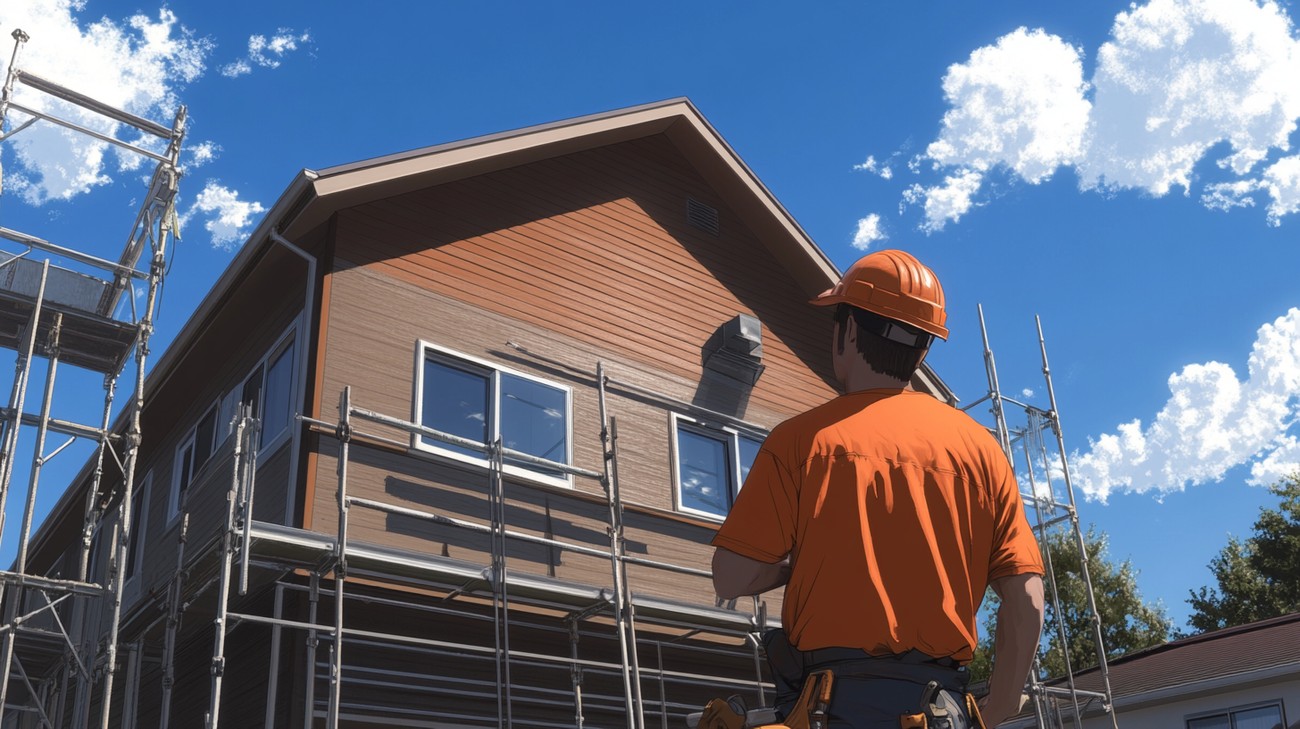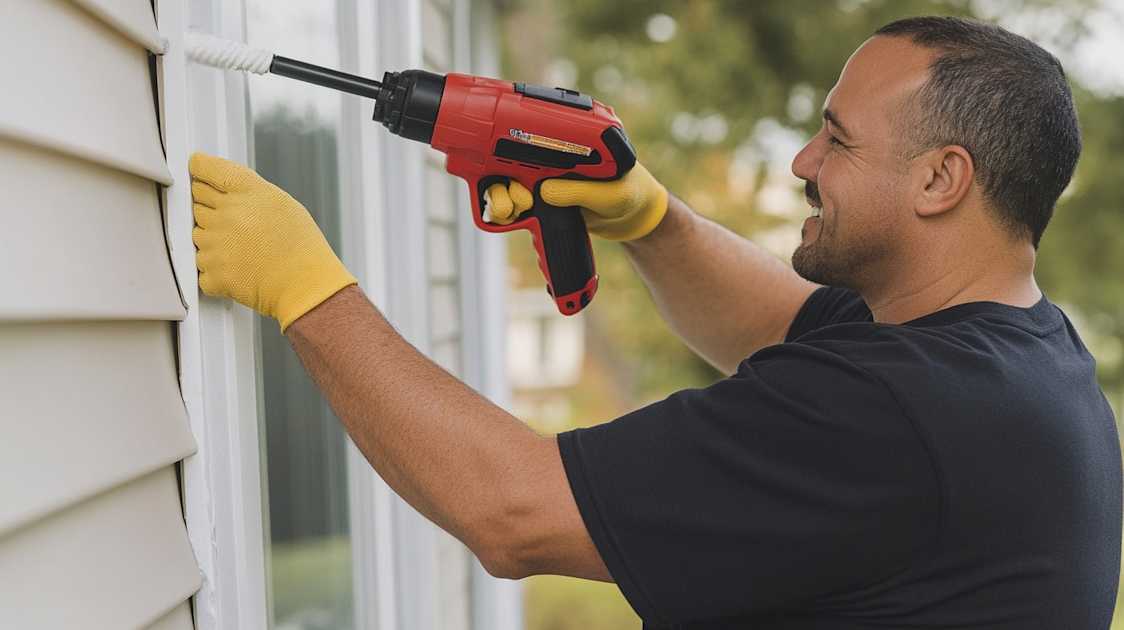Siding is an integral part of your house’s structure, protecting it from external elements. However, even the best siding will occasionally require maintenance, and a common method is using siding caulk. This weather-resistant adhesive is used to seal siding materials, ensuring a durable and long-lasting finish.
This blog delves into everything you need to know about siding caulk. We will investigate what it is, why you need it, how to choose it, and how to apply it correctly.
Understanding Siding Caulk
Primarily, siding caulk is used to fill gaps in your house's siding, offering enhanced protection against moisture, pests, and air leaks. It is an essential tool in enhancing your home's energy efficiency and overall longevity. Silicone, latex, polyurethane, and butyl are some common materials used to manufacture siding caulk.
Importance of Siding Caulk
- Prevent Moisture Damage: Any gaps in your siding can allow moisture to permeate through, potentially causing significant structural damage. Caulk will seal these gaps tightly, preventing water from intruding.
- Enhance Energy Efficiency: By sealing air leaks, caulk can help ensure that your heating and cooling systems operate more efficiently, saving you significant sums in energy costs.
- Pest Protection: Small animals and insects can take advantage of siding gaps to infiltrate your home. Caulking your home's siding helps you avoid these uninvited guests.
- Aesthetic Appeal: Siding caulk not only acts as a shield against various elements but also ensures that your house maintains its aesthetic appeal, contributing to its curb appeal and ultimate resale value.
How to Choose the Right Siding Caulk
When it comes to siding caulk selection, you must consider factors like weather conditions, siding material, and the size of the gaps.
Consider the Weather Conditions
Some caulks may not withstand extreme weather conditions. For instance, silicone-based caulks are more flexible and can withstand considerable temperature variations, making them ideal for areas experiencing severe weather conditions.
Evaluate the Siding Material
The siding material you have will determine which caulk is best suited for your needs. For instance, polyurethane-based caulk is ideal for materials like wood, masonry, and fiber cement.
Size and Position of The Gap
The caulk you choose should suit the size and location of the gaps. Use a thicker caulk for larger gaps, as it will ensure a better seal.
At this juncture, it's critical to note that you should always follow the manufacturer's instructions on the caulk label to ensure you achieve maximum effectiveness.
A Step-by-Step Guide on Applying Siding Caulk
Step 1: Clean the Area
First, ensure your siding is clean and dry. Use a brush or compressor to remove dirt, dust, or old, deteriorated caulk.
Step 2: Apply the Caulk
Cut the caulk tube tip at a 45-degree angle. Using a caulking gun, apply a bead of caulk to any cracks or gaps in your siding. Make sure the bead is large enough to cover the gap or crack entirely.
Step 3: Smoothing Out the Caulk
Use a smoothing tool or your finger (with a disposable glove) to smooth out the caulk. This step will evenly distribute the caulk and ensure a neat finish.
Step 4: Let it Cure
Different caulks have different curing times, so allow it to cure as per the manufacturer’s instructions. Avoid rain or humidity until the caulk is entirely dried out.

Frequently Asked Questions about Siding Caulk
What type of caulk should I use for siding?
The type of caulk you should use will depend on the specific needs of your siding. In general, you should look for a high-quality, exterior grade caulk. Silicone-based caulk is often recommended for siding because of its excellent weather resistance and durability. However, there are also acrylic and polyurethane caulk options that may be appropriate for certain types of siding.
When should I apply caulk to my siding?
Siding caulk should be applied after the siding has been installed and before any exterior painting is done. The caulk should be applied in a continuous bead along the length of the joint or gap, and then tooled or smoothed out to ensure a good seal. Ideally, caulking should be done on a dry, warm day to ensure the caulk adheres properly to the siding.
How often should I replace or redo the siding caulk?
As a general rule, siding caulk should be inspected once a year and replaced as needed. Over time, caulk can harden, crack, or peel away from the siding, reducing its effectiveness. Signs that you need to replace your siding caulk include visible cracks or gaps in the caulk, water intrusion, or drafts.
Can I paint over siding caulk?
Yes, you can paint over siding caulk, but it is important that you use a type of caulk that is paintable. Silicone caulk, for instance, is not typically receptive to paint. On the other hand, acrylic and polyurethane caulk can be painted over without problems. Always be sure to check the caulk’s label to see if it is paintable before making your purchase.
Why is my siding caulk cracking?
Siding caulk can crack for various reasons. Fluctuating weather conditions, improper application, or using the wrong type of caulk can all result in cracking. By using a high-quality caulk designed for siding application, applying it correctly, and performing regular maintenance, you can prevent and minimize cracking.
How to properly apply siding caulk?
Properly applying siding caulk starts with surface preparation. Clean and dry the areas to be caulked. Apply the caulk in a continuous bead along the joint or gap, and use a caulking tool or your finger to tool the caulk, pressing it into the joint and smoothing the surface. Allow the caulk to cure according to the manufacturer's instructions.
Can I apply siding caulk in cold weather?
While it's typically best to apply siding caulk in warm, dry weather, there are certain products available that can be applied in colder temperatures. However, it's important to read and follow the manufacturer's instructions, as applying caulk in conditions outside of its specified range can lead to poor adhesion and sealing performance.
What are some recommended siding caulk brands?
There are many quality brands of siding caulk available on the market. Some recommended ones include DAP, GE, and Sashco. These companies offer a range of caulking products that provide excellent adhesion, flexibility, and weather resistance, making them suitable for use on siding.

Pros of Siding Caulk
1. Durability
Siding caulk is known for being incredibly durable. It is made from top-quality materials that can withstand many elements, such as heat, cold, moisture, and UV rays, maintaining its integrity and effectiveness for a long period.
Excellent Weather Resistance
Siding caulks are designed to withstand all types of weather conditions, from scorching heat to freezing temperatures. It is water and mold resistant and does not crack or shrink over time, which can help to protect your home from potential water damage.
2. Flexible
Accommodates Material Expansion
Siding caulk is extremely flexible, which enables it to accommodate the natural expansion and contraction of building materials. They have the ability to stretch and recover without losing adhesion making them an ideal choice for wood or vinyl sidings, which naturally expand and contract with changes in temperature.
3. Easy to Apply
Wide Variety of Application Methods
Siding caulk typically comes in a tube that can be easily applied using a caulking gun. There are also readily available in squeeze tubes for smaller applications. This makes the application process quicker, more convenient, and less messy.
4. Paintable
Allows for Customizable Aesthetics
Most types of siding caulk are paintable. This allows homeowners or builders to perfectly match the color of the siding caulk to the color of their home or building. This means that the caulking blends in seamlessly with the rest of your home's exterior, creating a clean, crisp, and professional finish.
Cons of Siding Caulk
1. Requires Regular Maintenance
Caulk Deterioration Over Time
Although siding caulk is known for its durability, it doesn't last forever. Over time, the caulk might deteriorate and become less effective at sealing gaps and preventing water infiltration. This means homeowners would need to regularly check the condition of the caulking and apply fresh caulk when necessary.
2. Difficult to Remove
Siding caulks forms a strong bond with the substrates and removing it can be quite challenging. If homeowners want to replace the caulk or make repairs, they might face the difficult task of stripping old caulk, which can be time-consuming and require the use of specific tools.
Need for Chemicals for Removal
While there are methods to soften caulk to aid removal, they often involve harsh chemicals which might not be environmentally friendly and can pose potential health risks if improperly handled.
3. Limited Color Options
While it is true that siding caulk can be painted, the direct color options available for these caulk are usually limited. Most come in white, clear, or a small range of standard colors. For an exact color match without the need for painting, homeowners or builders might struggle to find the perfect siding caulk.
4. Cost
High-quality siding caulk can be pricey. The cost can add up, especially for larger houses or buildings. And considering that caulk application is not a one-time thing and needs to be redone over time, this could mean significant expense over the long run.
5. Skill Required for Application
Challenges for DIY Projects
Caulking might seem simple, but if done incorrectly, it can look messy and might not properly seal the gaps. Achieving a smooth, neat, professional line of caulk requires some practice and skill, posing a challenge for those wanting to DIY their home projects.

Myths and Misconceptions About Siding Caulk
Keeping your siding in good condition is essential to maintaining both the appearance and functionality of your home. Part of that maintenance often involves the use of siding caulk. However, a variety of myths and misconceptions exist about this important household product. In this section, we'll delve into these misconceptions, highlighting what's true, what's not, and providing you with the accurate information you need when dealing with siding caulk.
Myth 1: All Caulks Are the Same
It's easy to walk into a hardware store, pick up the first caulk you see on the shelf, and assume it will get the job done. The truth, however, is that not all caulks are created equal.
Misconception: One Size Fits All
Siding caulk comes in a variety of types designed for different uses. For instance, some caulks are designed for interior use, while others are intended for exterior application. Some can withstand high temperatures; others function better in colder climates. Selecting the right type of caulk for your project can make a huge difference in both the ease of application and the final result.
Truth: The Right Caulk for the Job
Depending on your siding type and weather conditions, you may need to select a specialized caulk. For instance, if you have vinyl siding, you would use a different caulk compared to someone with wooden or metal siding. Further, some caulk types are specifically designed to resist UV light or extreme temperatures.
Myth 2: Caulk is Only for Small Gaps and Cracks
Siding caulk's ability to seal gaps and cracks is well known. However, a misconception exists that caulk can only be used for small, minor repairs.
Misconception: Limited Usage
Some people believe that siding caulk is only useful for minor repairs, like sealing small gaps or cracks. They might think that larger issues require a more substantial solution.
Truth: Versatile Caulk Uses
In reality, siding caulk can be used for more than just minor gap sealing. It can also be used to seal siding joints, around windows and doors, or even between different types of materials. In some cases, a thick bead of caulk may be all it takes to fix a substantial leak or draft in your siding.
Myth 3: Once Applied, Siding Caulk Lasts Forever
It would certainly make life simpler if this were true, but unfortunately, it isn’t. Different types of caulk have different lifespans, and none of them lasts forever.
Misconception: The Promise of Permanency
It's easy to assume that once you apply siding caulk, that's the end of the story. Unfortunately, this isn't true. Caulk eventually cracks, dries out, or becomes ineffective over time due to weathering and aging.
Truth: The Importance of Regular Maintenance
Caulk maintenance is important. Depending on the type of caulk used and the conditions it faces, it may need to be replaced every few years. Check your caulking regularly for signs of wear or damage, and be prepared to re-caulk as needed to ensure your siding is properly protected.
Myth 4: Caulk is the Ultimate Solution for All Siding Problems
While siding caulk is certainly useful, it has its limitations, and it's not always the best solution to every siding problem you encounter.
Misconception: Caulk Saves the Day
There's a myth that a little bit of caulk can solve any issue with your siding. Whether it's a substantial gap or a bit of moisture seeping in, some people might think that siding caulk can single-handedly resolve the issue.
Truth: Other Solutions May be Required
While siding caulk can mitigate a myriad of issues with your siding, remember, it's a sealant, not a miracle cure. Sometimes, siding problems are due to underlying issues such as mold growth, rot, or structural damage. In these cases, a more comprehensive solution may be required beyond just caulking.
Understanding these myths and misconceptions about siding caulk can help homeowners make the right decisions for maintaining and repairing their home. By choosing the appropriate type of caulk, knowing where and when to apply it, and remaining vigilant about maintenance, you can effectively use siding caulk to aid in the longevity and efficiency of your home’s siding.
Summary
Caulking is a critical aspect of siding maintenance; it helps to seal gaps, prevents water infiltration, and keeps your home insulated. One of the best solutions for this is siding caulk. It's reliable, easy to work with and it provides the durability that your home deserves. So when it's time for some touch-ups or a full re-caulking, consider siding caulk as your go-to.
Having a weather-resistant, versatile, and long-lasting material such as siding caulk can undoubtedly increase the lifespan of your siding. It's great for tackling those tricky areas prone to water seepage and drafts. Besides, it's not complicated; even DIY enthusiasts can handle a tube of caulk and make their homes warm and watertight.
Don't underestimate the importance of keeping your siding in top shape. That little bit of effort you put into maintenance can save you many headaches down the line. And thanks to siding caulk, it's a task that can be comfortably managed. So take that step today, equip yourself with some quality siding caulk, and protect your home for the many seasons yet to come. Because at the end of the day, your home deserves the best.
About US Quality Construction of Columbus
US Quality Construction of Columbus is your go-to construction company in Columbus, OH. We love what we do and have a real passion for delivering top-notch service to our community. We have a team of skilled professionals who have been in the construction industry for years. Our team works with cutting-edge tools and technologies to ensure that we're delivering the best service possible. We specialize in both commercial and residential projects and believe that no job is too big or too small. Get in touch with us and let's make your construction dreams a reality!
Tags: siding, caulk, home improvement,









